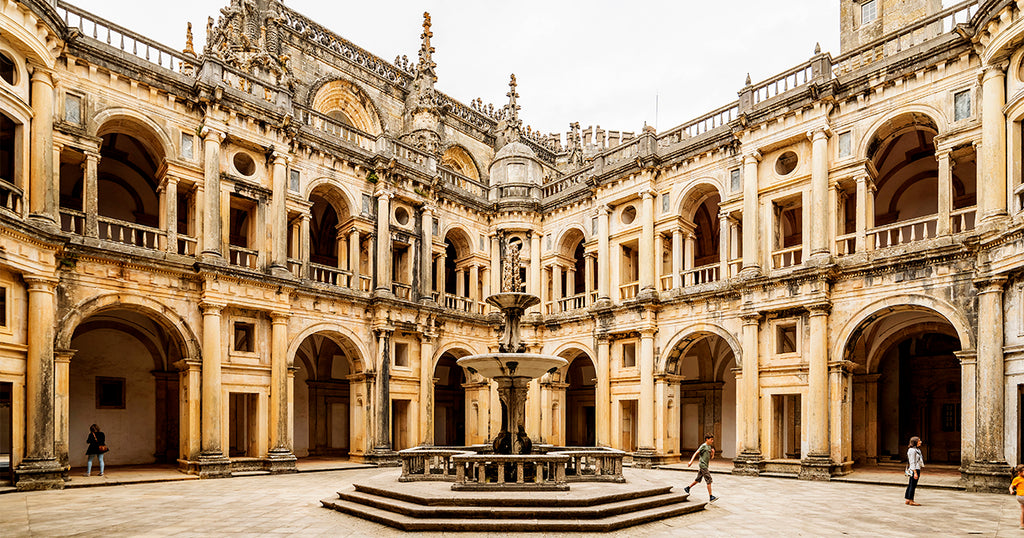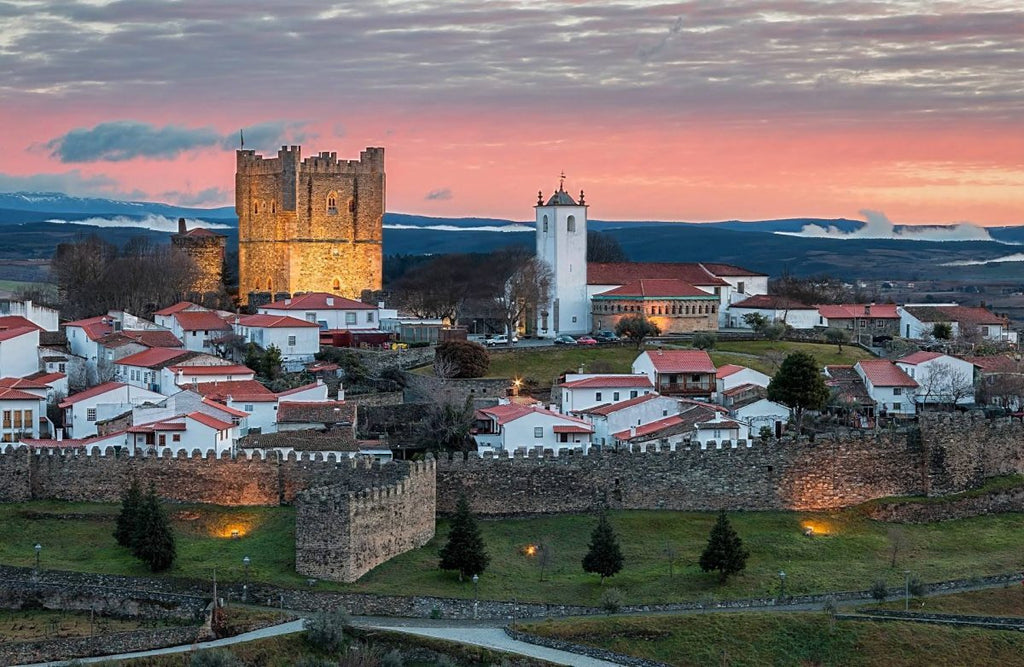Portugal, a small country boasting a strategic position, has had to conquer and defend its territory throughout the centuries.
Its long history is marked by the reconquest following the Moorish occupation, territorial wars against Spain, and participation in the Crusades, which fostered a strong chivalrous culture.
Throughout this eventful history, castles have played a vital role in protecting borders and communication routes, symbolizing power and prestige for knights and local lords.
Today, these castles represent a precious heritage of the country's history and popular tourist attractions, offering visitors a fascinating glimpse into medieval life and construction techniques of the time.
Providing an exact number of medieval castles in Portugal is challenging, as it depends on the specific definition of a medieval castle and the classification of different historical sites. However, it is estimated that there are over 200 castles and fortresses scattered throughout the country.
We have selected 10 castles that are likely the most symbolic ones.
- Castelo de Óbidos - 7th century
- Castelo dos Mouros - 8th century
- Castelo de Guimarães - 10th century
- Castelo de São Jorge - 11th century
- Château de Santa Maria da Feira - 11th century
- Castelo de Tomar - 12th century
- Castelo de Almourol - 12th century
- Castelo de Bragança - 12thcentury
- Castelo de Marvão - 13th century
- Castelo de Monsaraz - 13thcentury
Castelo de Óbidos - 7th century
Perched on a hill overlooking the picturesque town of Óbidos in the Western region of Portugal, you'll find the Castelo de Óbidos, a medieval fortress that transports visitors to another time.
With its imposing ramparts, cobbled streets, and preserved medieval ambiance, this castle is one of Portugal's architectural gems.

Castelo de Óbidos dates back to Roman times, but was rebuilt and fortified by the Moors in the 7th century.
Later, in the 14th century, the castle became the property of Queen Isabel, wife of King Dom Dinis. Since then, it has been given to several Portuguese queens as a dowry on their marriage, earning it the nickname "Cadeia das Rainhas" (Prison of the Queens).

The entrance is dominated by an imposing gate flanked by two cylindrical towers. Once inside, the narrow streets of the medieval village that grew up within the walls appear. Traditional houses with white facades, adorned with colorful flowers, create a picturesque and inviting atmosphere.

The highlight of a visit to Castelo de Óbidos is a walk on the ramparts, which offers a breathtaking view of the town and its surroundings. You can stroll freely along the crenellated walls, admire the watchtowers and imagine the daily lives of the soldiers and inhabitants who have lived there over the centuries.

Inside the castle walls is the 12th-century church of Santa Maria.
Its Baroque interior is richly decorated, with gilded altars and traditional azulejos. The church also houses the parish museum, which exhibits precious religious objects and works of art.

Igreja de Santa Maria em Óbidos - Crédit Center of Portugal
Castelo de Óbidos is also famous for its annual festival, during which the town is transformed into a bustling medieval marketplace. Performances by knights in armor, jugglers, musicians and artisans in period costumes enliven the streets, creating a festive and immersive atmosphere.

Castelo dos Mouros - 8th century
Castelo dos Mouros, also known as the Moorish Castle, is a medieval castle located in Sintra, 1/2 hour from Lisbon. Its history dates back to the 8th century, at the time of Moorish domination of the Iberian Peninsula.

The castle was built by the Moors, a population of Berber and Arab origin, who occupied the Sintra region. It was built on a steep hill, offering panoramic views of the surrounding area and serving as a strategic surveillance point.
 Castelo dos Mouros - Crédit Lonely planet
Castelo dos Mouros - Crédit Lonely planet
Castelo dos Mouros is a defensive fort, designed to control the routes to Mafra and Lisbon and protect the region from outside invasion.
It features fortified walls, watchtowers and a sophisticated defense system. For several centuries, it played a crucial role in defending Moorish territory from outside attack.

In the 12th century, the Christian forces of Portugal launched the "Reconquista", a campaign to reconquer territories occupied by the Moors. In 1147, the castle was conquered by Afonso Henriques, the first king of Portugal, and integrated into the nascent kingdom.
Over the centuries, the castle lost its strategic importance and gradually fell into ruin. It wasn't until the 19th century that restoration efforts were undertaken. The work was overseen by King Ferdinand II of Portugal, a man with a passion for architecture and history.
Today, Castelo dos Mouros is a major tourist attraction in Sintra. Here, you can explore the castle ruins, admire the panoramic views over the town and surrounding area, and discover the fascinating history of this medieval fortress that bears witness to Portugal's rich history.
A particular feature of Castelo dos Mouros is the system of underground cisterns used to store water, essential to withstand prolonged sieges. These cisterns, still visible today, bear witness to the ingenuity of the Moorish builders.
Castelo de Guimarães - 10th century
The Castelo de Guimarães is an emblematic monument located in the city of Guimarães, in northern Portugal. It is one of the country's most important castles, not only for its impressive architecture, but also for its historic role as the cradle of the Portuguese nation.

This medieval castle was built in the 10th century and is considered the birthplace of Portugal, due to its connection with the first Portuguese king, Afonso Henriques. Legend has it that Afonso Henriques was born here in 1111.
It features several towers, imposing walls and a picturesque inner courtyard. The entire château is open to visitors, including the reception rooms, former kitchens and chapel.

The castle's architecture is typical of the medieval period, with its stone walls and battlements. Defensive features such as moats, watchtowers and bastions add to its imposing appearance.
In addition to its historical interest, the castle is also a cultural gathering place. Special events, festivals and historical re-enactments are held here throughout the year, offering visitors an immersive experience of Portugal's glorious past.

As you explore the area around the castle, don't miss the historic quarter of Guimarães, a UNESCO World Heritage Site. The cobbled streets, traditional houses and picturesque squares create a charming atmosphere and invite you to explore.
Castelo de São Jorge - 11th century
Dominating Lisbon's São Jorge hill, São Jorge Castle is a true symbol of Portuguese history and culture. Dating back to the 11th century, this medieval fortress is one of the Portuguese capital's most emblematic attractions.

With its imposing walls, watchtowers and breathtaking panoramic views of the city and Tagus River, São Jorge Castle offers an unforgettable experience.
São Jorge Castle has a rich history dating back to Moorish times, when Lisbon was under Muslim rule. It was conquered by the Christians in the 12th century and played a key role in the city's defense for several centuries.
Over time, the castle has witnessed a variety of historical events, from epic battles to periods of prosperity and decline. Today, it stands as a fascinating testimony to Portugal's eventful history.

São Jorge Castle boasts an impressive fortified enclosure, with thick walls and imposing watchtowers. Inside, you'll find archaeological ruins, lush gardens and even an ancient cistern. The main structure also houses a small museum showcasing archaeological finds and historical artifacts.

In addition to its impressive architecture, São Jorge Castle also offers magnificent gardens and green spaces in which to relax, enjoy the tranquility of the patios and admire the various species of plants and trees. These green spaces also offer picturesque views over Lisbon, creating a peaceful and serene atmosphere.
Castelo de Santa Maria da Feira - 11th century
The Castle of Santa Maria da Feira, also known as Feira Castle, was built in the 11th century during the Moorish period. It was erected on a strategic hill that offered an unobstructed view of the surrounding region and served as a vital defense point.

Over the centuries, the castle has undergone several modifications and extensions, reflecting the influences of different periods in Portuguese history, notably medieval and baroque.
The castle is distinguished by its impressive fortified enclosure, with thick stone walls and imposing watchtowers. Exploring the castle's interior reveals a picturesque courtyard, manicured gardens and richly decorated rooms.

The castle's Gothic chapel is another architectural highlight, with its magnificent vaults and sculpted details.
The Castle of Santa Maria da Feira also houses a museum that traces the history and culture of the region. Exhibits include historical artifacts, ancient weapons, traditional costumes and archival documents.

The Castle of Santa Maria da Feira is also a lively place, regularly hosting cultural events and festivities. The annual medieval festival is one of the highlights of the year, when the streets of Santa Maria da Feira are transformed into a lively medieval market.
Castelo de Tomar - 12th century
In the picturesque town of Tomar, in the heart of Portugal, stands an impressive fortress that epitomizes medieval history and architecture: the Castelo de Tomar.
Erected on a hill overlooking the Nabão river valley, this majestic castle bears witness to the country's glorious past.

Construction of Castelo de Tomar began in the 12th century, but the site itself dates back to Roman times.
Originally conceived as a Templar castle, it was later enlarged and renovated by the Order of Christ, successor to the Knights Templar in Portugal. The mission of these knights was to protect the pilgrimage routes to Santiago de Compostela and defend the country against Moorish invasions.

As you enter the castle grounds, you're immediately struck by its imposing architecture and intricate details. Massive ramparts, crenellated towers and ogival windows give the castle an aura of power and elegance.
At the heart of Castelo de Tomar lies the Charola, a unique circular church that was the place of worship of the Knights Templar.
This unique church features a combination of Romanesque and Gothic elements. Inside, remarkable medieval religious frescoes adorn the walls, creating a mystical, spellbinding atmosphere.

Charola do-Convento de Cristo - Crédit Municipio de Tomar
Further exploration of the castle also reveals the Convento de Cristo, a monastery built in the 14th century. This impressive monastic complex includes a church, cloisters and tranquil gardens. The interior is richly decorated, with elaborate architectural details and exceptional works of art.

Castelo de Tomar is also known for its ingenious defense system, including moats, secret tunnels and underground passages. These features testify to the advanced military strategy put in place to protect the castle and its inhabitants.
Today, Castelo de Tomar is a UNESCO World Heritage Site, and has become one of Portugal's main tourist attractions.
Castelo de Almourol - 12th century
Nestled on a small, rocky island in the middle of the Tagus River, in Portugal's Central Region, lies an architectural treasure trove of mystery and romance: the Castelo de Almourol.

Castelo de Almourol dates back to the 12th century and was built by the Knights Templar, an order of soldier-monks charged with defending Christian lands during the Crusades. Its strategic position on the island and its imposing architecture make it a symbol of power and resistance.
To reach the castle, visitors must take a traditional boat from the nearby village of Vila Nova da Barquinha.
Crossing the river already offers a breathtaking view of this mysterious fortress looming on the horizon. Once on the island, climb the steep steps to the castle entrance.

Castelo de Almourol stands proudly with its stone walls, crenellated towers and imposing keep. You can explore the different parts of the castle, some of which have been restored to provide a better understanding of its history and architecture.
The ramparts offer panoramic views of the river and surrounding area, creating a breathtaking panorama.
Castelo de Bragança - 12th century
Portugal is full of fascinating castles, and among them is Castelo de Bragança, an imposing fortress located in the eponymous town of Bragança.
This medieval castle is an architectural gem offering a captivating glimpse into the country's history. With its massive walls, watchtowers and strategic location, Castelo de Bragança is a must-see destination for lovers of heritage and time travel.

Castelo de Bragança dates back to the 12th century, when it was built to defend the border between Portugal and Spain.
Over the centuries, it has been the scene of numerous conflicts and battles, testifying to the strategic importance of the region. For a time, it even served as the royal residence of the Portuguese noble family of Bragança.
Castelo de Bragança stands out for its well-preserved medieval architecture. You can admire its massive stone walls, imposing watchtowers and impressive fortified enclosure.
Inside the castle, you'll find charming patios, cobbled passageways and richly decorated rooms. The Menagem Tower, the castle's highest tower, offers panoramic views of the city and surrounding area.

The castle also houses a museum highlighting the history and culture of the Bragança region. On display are historical objects, ancient weapons, traditional costumes and archival documents.
Castelo de Bragança is also the scene of various events and festivities throughout the year.
The annual medieval festival is one of the highlights, when the castle and its surroundings are transformed into a bustling medieval marketplace. Visitors can enjoy theatrical performances, knightly tournaments, costume parades and demonstrations of traditional crafts.

Castelo de Marvão - 13th century
At the heart of the Alentejo region in southern Portugal lies an architectural treasure trove steeped in history and breathtaking beauty: Castelo de Marvão.
This majestic medieval fortress stands proudly on a rocky ridge, offering breathtaking panoramic views of the surrounding area.
 Castelo de Marvão - Credit allaboutportugal
Castelo de Marvão - Credit allaboutportugal
Castelo de Marvão is nestled in the eponymous town of Marvão, on the Spanish border. Construction of the castle began in the 13th century, but its origins date back to Roman and even pre-Roman times. It was designed as a strategic defensive bastion, perched at an altitude of almost 900 meters, making it one of the highest castles in Portugal.
As you approach Castelo de Marvão, you're immediately struck by its impressive walled enclosure, which extends over some 13,000 square metres. Sturdy ramparts, crenellated towers and imposing bastions testify to the power and grandeur of this fortress. Castelo de Marvão - Credit Hoteis do Campo
Castelo de Marvão - Credit Hoteis do Campo
One of the most remarkable features of Castelo de Marvão is its breathtaking panoramic view over the surrounding valley. The view from the top of the ramparts is breathtaking, with rolling green hills, picturesque villages and even the mountains of neighboring Spain. The sunsets from the castle are particularly spectacular and well worth the detour.
Castelo de Monsaraz - 13th century
Perched majestically on a hilltop in Portugal's Alentejo region is the Château de Monsaraz.
A true medieval gem, this fortified castle offers not only a breathtaking view of the surrounding plains, but also a journey back in time through the history of Portugal.

Monsaraz Castle was built in the 13th century to reinforce the border between Portugal and Spain. It witnessed many conflicts and battles over the centuries, but its strategic position made it an essential point of defense for the region.
The castle is surrounded by a fortified enclosure, whose thick walls are still well preserved. Inside the castle, you'll find narrow, winding lanes, whitewashed stone houses and a picturesque Gothic church. The clock tower is another notable feature, offering panoramic views of the surrounding region.

Monsaraz Castle is also known for its commitment to art and culture. The town is home to many local artisan workshops where you can discover traditional works of art, such as pottery and basketry.
There are also festivals and cultural events showcasing the region's traditions and crafts.



1 comment
I am currently writing a novel that takes place in the Middle Ages and these images of castles in Portugal served me well. Thank you for sharing them! They are absolutely stunning.